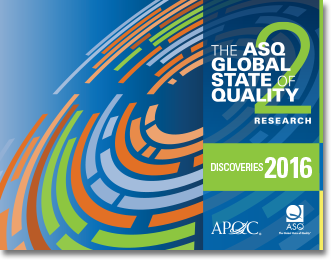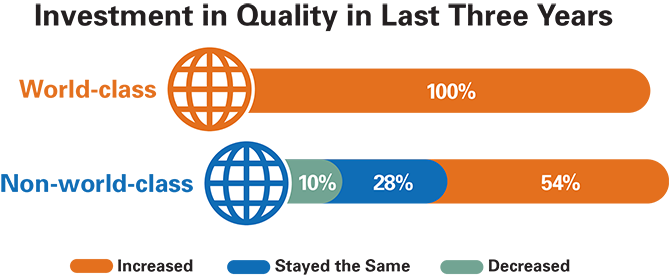The American Society of Quality (ASQ) and APQC conducted in 2016 the second iteration of the Global State of Quality Research, which provides an analysis of nearly 1,700 companies. The research results are included in the qualitative and quantitative Discoveries 2016 report, which addresses topics important to enhancing quality, including the influence of the customer, trends in industry standards, training systems, governance structures and more.
We come across a lot of very good information from contacts at PEDCO with Applied SAFe and the application of scaled agility in regulated environments. Usually we are not allowed to speak about such information. Recently we just came across a wonderful work of the American Society of Quality, we would like to make you aware of this worthwhile reading report: http://asq.org/global-state-of-quality
The ASQ Global State of Quality 2 Research builds on the Global State of Quality initiatives of 2013, again providing a comprehensive, global, and quantitative view of the state of quality and continuous improvement worldwide. The results and analysis provides organizations the bench-mark data needed to further develop continuous improvement practices and enhance quality programs. Here’s a glimpse of what ASQ learned in 2016.
We liked very much the summary of ‘Implications and Opportunities: Back, Forth and Now‘ in the report starting on page 41.
In this report, ASQ revisited many of the Discoveries 2013 themes, including:
- Quality governance and management,
- Outcomes and measures,
- Competencies and training, and
- Culture.
ASQ states that since the first report, a dramatic shift has occurred in how quality resources and departments are viewed within organizations.
Top-performing organizations view quality as a strategic asset that helps competitively differentiate product and service offerings.
As quality becomes more of a competitive differentiator, opportunity exists for organizations to measure the financial impact of quality on their business. Additionally, setbacks and challenges are always going to be part of the quality industry; however, minimizing those setbacks and capturing the lost efficiency and financial impact associated with them, seems to be a lost opportunity among many respondents.
ASQ noted a shift in the role the customer plays within organizations. While the data indicates the Qustomers’ importance and influence have increased since the inaugural report in 2013, the customer is—of course—not the solitary force defining what quality means. With a broader lens,we revisited the “Qustomer” concept (customer and quality) and the ties that affect organizational business goals and operational objectives. The insights provide good news as well as opportunities for improvement across all organizations.
Another change detected in 2016 data is in the profession itself—management and leadership in competencies and culture. As leaders and professionals in quality and continuous improvement retire and the generational shift accelerates, tacit and explicit knowledge can literally walk out the door. Capturing that knowledge and training up-and-coming quality leaders will separate leading organizations from laggards. Finally, Discoveries 2016 scratches the surface of world-class quality—what it is and what it takes to achieve.
In that spirit and in closing, the American Society of Quality offers a top 10 action list to help your organization advance toward world-class quality.
We at PEDCO think, that this list is very valuable and therefore reproduce this list here.
10 Steps to World-Class Quality, 2016—2020
- Evaluate to what degree your quality organization and senior executive management understand and leverage quality and continuous improvement throughout the enterprise, as a competitive differentiator and as a strategic asset.
- Assess your organization’s culture of quality to identify strengths and opportunities (see asq.org/culture-of-quality/assessment/).
- Inventory the quality and continuous improvement measures your organization uses and the reporting frequency and degree of visibility or transparency for those measures. Then, enact steps to improve and accelerate the decision-making process based on critical metrics.
- Measure and communicate expenses reduced and avoided through quality and continuous improvement efforts, as well as top-line revenue growth and customer loyalty gained.
- Review the incentives your organization provides to drive quality performance. Improve and align incentives and rewards to recognize positive results, behaviors, and overall performance from the senior ranks to those closest to your customers and suppliers.
- Create plans and programs and leverage technology to ensure knowledge is transferred and built upon so that wisdom and experience is shared, locally and globally.
- Review the types of quality-related training your organization needs and any new competencies needed; assess gaps and opportunities to develop new skills and analytics; and tie these investments to the overall business operations and strategy.
- Perform a thorough review to assess the intersection between the customer and quality (such as sharing feedback with the customer, metrics on performance against customer needs is shared internally, etc.) and identify gaps and opportunities.
- Assess the quality processes and management systems between your organization and those throughout the supply chain and sourcing; prioritize gaps and opportunities; and develop a joint strategy to improve performance, short- and long-term.
- Note the gaps between your organization and the world-class profile, and determine where you could better connect quality and continuous improvement plans, programs, and priorities—both today and tomorrow—to your:
– Business focus and strategy,
– Key measures,
– Talent management and training,
- Industry and management understanding, use, and compliance with standards, and
- Technology, automation, and big data.
We recommend for people interested in quality to download and read this report at http://asq.org/global-state-of-quality





